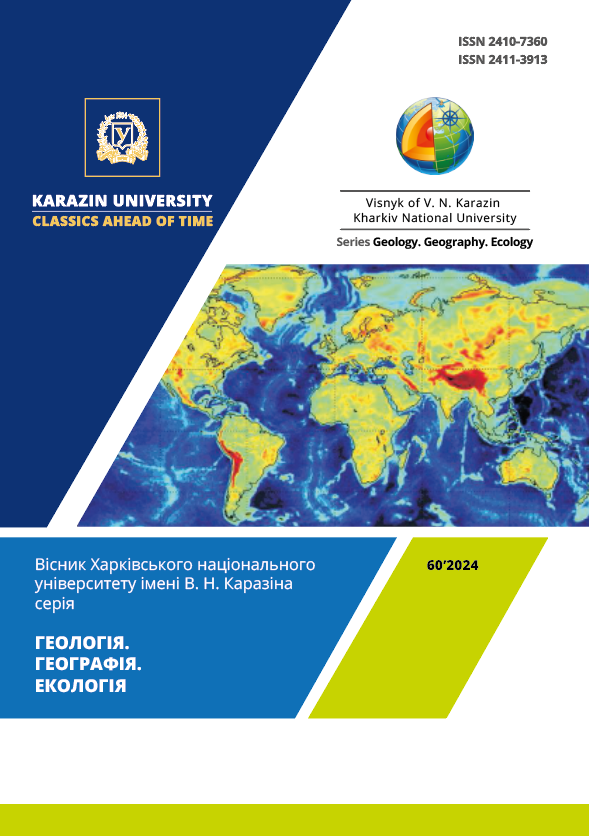Influence of the sea surface temperature of equatorial Pacific Ocean on the tropical cyclones activity
Abstract
Introduction. Today, the study of climate is one of the most important tasks of modern science. Particular attention is paid to issues of climate variability on different time scales. The El Niño – Southern Oscillation (ENSO) is the leading signal of interannual climate variability that influences the weather and climate of the globe. It has been revealed that during the onset of its different phases, weather and climate anomalies (up to extreme ones) are observed not only over the tropical zone of the Pacific Ocean, but also in extratropical latitudes, which are transmitted through teleconnections in the ocean-atmosphere system. Numerous studies have shown that ENSO modulates tropical cyclone activity in the northwest Pacific Ocean.
The purpose of the study is to determine the relationship between sea surface temperature (SST) changes in the equatorial Pacific Ocean and the frequency of tropical cyclones of varying intensity in the northwestern Pacific Ocean under current climatic conditions.
Materials and methods of research. The work uses data of the number of cases and intensity of tropical cyclones (TCs) for the period 1991-2020, and series of indices ONI and SOI. Using these data, statistics on the frequency of TCs in the study area were calculated and Pearson correlation coefficients were calculated.
The scientific novelty lies in obtaining quantitative characteristics of the relationship between SST and the number of TCs of varying intensity in modern climatic conditions.
The practical significance of the work lies in the fact that TCs are associated with the occurrence of severe weather conditions, which, when a TC reaches the densely populated coast of Southeast Asia, can pretend to be significant losses. Therefore, information that can be used in forecasting TCs and their trajectories is very high importance.
Research results. Analysis of the frequency of TCs of different intensity in the northwestern Pacific Ocean during the 1991-2020 showed that there was a decrease in the number of tropical depressions and typhoons. However, there has been a slight increase in the occurrence of tropical storms. The results of the analysis of the influence of SST variability in the equatorial Pacific Ocean on the frequency of TCs, showed that there is a statistically significant relationship only with the frequency of typhoons. The establishment of positive SST in the center of the equatorial Pacific Ocean, associated with the El Niño episode, is associated with an increase in typhoons in the northwestern Pacific Ocean.
Downloads
References
Chiew, F.H.S., Piechota, T.C., Dracup, J.A., McMahon, T.A. (1998). El Nino/Southern Oscillation and Australian rainfall, streamflow and drought: Links and potential for forecasting. Journal of Hydrology, 204(1-4), 138-149. https://doi.org/10.1016/S0022-1694(97)00121-2
Huang, A.T., Gillett, Z.E. & Taschetto, A.S. (2024). Australian Rainfall Increases During Multi-Year La Niña. Geo-physical Research Letters, 51(9), e2023GL106939. https://doi.org/10.1029/2023GL106939
Wang Z., Chang C. & Wang B. (2007). Impacts of El Niño and La Niña on the U.S. Climate during Northern Summer. J. Climate, 20, 2165-2177. https://doi.org/10.1175/JCLI4118.1.
Hafez, Y. (2016). Study on the Relationship between the Oceanic Nino Index and Surface Air Temperature and Pre-cipitation Rate over the Kingdom of Saudi Arabia. Journal of Geoscience and Environment Protection, 4, 146-162. https://doi.org/10.4236/gep.2016.45015
Rouault, M., Dieppois, B., Tim, N., Hünicke, B. & Zorita, E. (2024). Southern Africa Climate Over the Recent Dec-ades: Description, Variability and Trends. In: Sustainability of Southern African Ecosystems under Global Change (Ecological Studies, vol 248). Cham: Springer. https://doi.org/10.1007/978-3-031-10948-5_6
Brönnimann, S. (2007). Impact of El Niño–Southern Oscillation on European climate. Reviews of Geophysics, 45(3), RG3003. https://doi.org/10.1029/2006RG000199
Rohli, R.V., Snedden, G.A., Martin, E.R. & DeLong, K.L. (2022). Impacts of ocean-atmosphere teleconnection pat-terns on the south-central United States. Front. Earth Sci., 10, 934654. https://doi.org/10.3389/feart.2022.934654
Arpe K., Bengtsson L., Golitsyn G.S., Mokhov I.I. & Semenov V.A., Sporyshev P.V. (2000). Connection between Caspi-an Sea level variability and ENSO. Geophys. Res. Lett., 27, 2693-2696. https://doi.org/10.1029/1999GL002374
Shang-Ping Xie. (2024). Tropical Atlantic variability. In: Coupled Atmosphere-Ocean Dynamics. Elsevier. https://doi.org/10.1016/B978-0-323-95490-7.00010-2
Ford, B.W. (2000). El Nino and La Nina effects on tropical cyclones: The mechanisms. Monterey, South Carolina : Naval postgraduate school Monterey https://core.ac.uk/download/pdf/36701239.pdf
Hastenrath, S. (2015). Tropical meteorology and climate: Tropical Climates. In: Encyclopedia of Atmospheric Sciences (Second Edition). Academic Press. https://doi.org/10.1016/B978-0-12-382225-3.00416-3
Jin, F.-F., Boucharel, J. & Lin, I.I. (2014). Eastern Pacific tropical cyclones intensified by El Niño delivery of sub-surface ocean heat. Nature, 516, 82-85. https://doi.org/10.1038/nature13958
Power, S.B. & Kociuba, G. (2011). The impact of global warming on the Southern Oscillation Index. Clim. Dyn., 37, 1745-1754. https://doi.org/10.1007/s00382-010-0951-7
Cai, W., Ng, B., Geng, T. et al. (2023). Anthropogenic impacts on twentieth-century ENSO variability changes. Nat Rev Earth Environ, 4, 407-418. https://doi.org/10.1038/s43017-023-00427-8
NCEI/NOAA. (2024). Available at: https://www.ncei.noaa.gov/access/monitoring/enso/sst (accessed 12.03.2024)
Ren, H.-L., Lu, B., Wan, J.H., et al. (2018). Identification Standard for ENSO Events and Its Application to Climate Monitoring and Prediction in China. J. Meteor. Res., 32(6), 923-936 https://doi.org/10.1007/s13351-018-8078-6
Australian government. Bureau of Meteorology. (2024). Available at: http://www.bom.gov.au/climate/glossary/soi.shtml (accessed 17.05.2024)
Chan, J.C.L. (1985). Tropical cyclone activity in the northwest Pacific in relation to the El-Nino Southern Oscilla-tion phenomenon. Mon. Wea. Rev., 113, 599-606. https://doi.org/10.1175/1520-0493(1985)113<0599:TCAITN>2.0.CO;2
Pudov, V.D. & Petrichenko, S.A. (2002). The El Niño and Tropical Cyclogenesis in the North-West Pacific. Investig. Mar., 30(1), 90-91. http://dx.doi.org/10.4067/S0717-71782002030100009
El Hadri, Y., Berlinskyi, M.A., Slizhe, M.O., & Deryk, O.V. (2023). Formation of surface temperature anomalies in the Gulf of Mexico under the influence of Hurricane Sally on September 11-17, 2020. ONU Bulletin. Ser.: Geo-graphical and geological sciences, 28, 1(42), 26-38. https://doi.org/10.18524/2303-9914.2023.1(42).282234 [in Ukrainian]
Wang, Q., Li, J., Jin, FF. et al. (2019). Tropical cyclones act to intensify El Niño. Nat Commun, 10, 3793. https://doi.org/10.1038/s41467-019-11720-w
Tran, T.L., Ritchie, E.A., & Perkins-Kirkpatrick, S.E. (2022). A 50-year tropical cyclone exposure climatology in Southeast Asia. Journal of Geophysical Research: Atmospheres, 127, e2021JD036301. https://doi.org/10.1029/2021JD036301
Francis, A.S. & Strahl, B.R. (2022). Joint typhoon Warning center annual tropical cyclone report 2020. JTWC Tech. Rep. https://www.metoc.navy.mil/jtwc/products/atcr/2020atcr.pdf
Tropical Cyclone Climatology. National Hurricane Center. NOAA/NCEP. Available at: https://www.nhc.noaa.gov/climo/?text (accessed 06.07.2024)

This work is licensed under a Creative Commons Attribution 4.0 International License.





